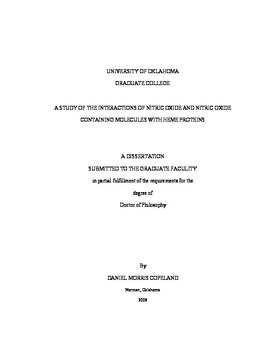| dc.contributor.advisor | Richter-Addo, George B., | en_US |
| dc.contributor.advisor | West, Ann H., | en_US |
| dc.contributor.author | Copeland, Daniel Morris. | en_US |
| dc.date.accessioned | 2013-08-16T12:20:24Z | |
| dc.date.available | 2013-08-16T12:20:24Z | |
| dc.date.issued | 2006 | en_US |
| dc.identifier.uri | https://hdl.handle.net/11244/1101 | |
| dc.description.abstract | The interactions of nitric oxide (NO), nitrite and organic nitroso compounds with heme proteins are biologically relevant. The formation of adducts between these NO-containing species and myoglobin (Mb) has served as a prototypical system for the interactions of nitroso compounds with heme proteins. We have prepared nitrosyl horse heart myoglobin using the two common synthetic routes, and we have determined that there are reproducible differences in the geometry of the FeNO moieties that depend on the synthetic method used. The 1.30 A resolution structure of the complex formed from the reaction of reduced myoglobin with NO gas revealed an FeNO angle of 120° and an Fe-NO bond length of 2.13 A. The 1.30 A resolution structure of nitrosyl hh Mb formed using nitrite and sodium dithionite revealed an FeNO angle of 144° and an Fe-NO bond length of 1.87 A. These differences are reproducible and suggest a role of the distal pocket in stabilizing conformational minima. | en_US |
| dc.description.abstract | Nitrosoalkane and nitrosoarenes are biologically significant compounds that are formed both by the oxidation of amine containing compounds (RNH 2) or the reduction of nitro compounds (RNO2). The resulting RNO compounds are known to bind to heme iron. We determined the 1.70 A resolution crystal structure of the Mb nitrosoethane complex (Mb(EtNO)), and the 1.60 A resolution crystal structure of the related Mb nitrosomethane complex (Mb(MeNO)). (Abstract shortened by UMI.) | en_US |
| dc.description.abstract | Recently, it has been shown that hemoglobin (Hb) and myoglobin catalyze the reduction of nitrite to NO under hypoxic conditions. Prior to our work, there was no reported crystal structure of a Hb-nitrite or Mb-nitrite complex. Therefore, obtaining the structure of the myoglobin nitrite adduct was an important goal in our research. In this thesis, we report the 1.20 A resolution structure of hh Mb(ONO) complex. The nitrite ligand binds to the heme iron through its oxygen forming an Fe-O-N-O linkage, with an Fe-O bond length of 1.94 A and an O-N-O angle of 113° . This complex was formed both by soaking a preformed metMb crystal with nitrite, as well as performing the Mb(ONO) adduct and crystallizing the complex. The only appreciable difference between the two structures is the lower occupancy of the nitrite ligand and partial occupancy of a water molecule in the latter cocrystallization method. | en_US |
| dc.format.extent | xiv, 148 leaves : | en_US |
| dc.subject | Hemoproteins. | en_US |
| dc.subject | Nitric oxide. | en_US |
| dc.subject | Myoglobin. | en_US |
| dc.subject | Chemistry, Inorganic. | en_US |
| dc.subject | Chemistry, Biochemistry. | en_US |
| dc.title | A study of the interactions of nitric oxide and nitric oxide containing molecules with heme proteins. | en_US |
| dc.type | Thesis | en_US |
| dc.thesis.degree | Ph.D. | en_US |
| dc.thesis.degreeDiscipline | Department of Chemistry and Biochemistry | en_US |
| dc.note | Source: Dissertation Abstracts International, Volume: 67-10, Section: B, page: 5724. | en_US |
| dc.note | Advisers: George B. Richter-Addo; Ann H. West. | en_US |
| ou.identifier | (UMI)AAI3237581 | en_US |
| ou.group | College of Arts and Sciences::Department of Chemistry and Biochemistry | |
